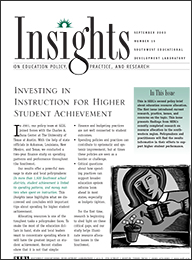At a Glance
Research over the past decade has begun to show how differences in spending patterns affect school and district performance in terms of student achievement. Because performance expectations are growing—and growing more specific and stringent—it is more important than ever to push forward with resource allocation research and make sure the results are widely known. This edition of Insights on Education Policy, Practice, and Research summarizes a recent SEDL study that explores the links between how resources are spent and the resulting performance of students. In particular, this brief gives state and local policymakers a clearer picture of district spending and results in four states in the SEDL region.
National trends hold up in the SEDL region.
- Although Southwest districts spend less than national averages, the general spending patterns tend to be roughly similar to what other researchers have found nationally.
- On average, about 60% of education dollars are spent on instruction, including teachers, books, and instructional programs.
Beneath the averages, important distinctions can be seen.
- Southwestern districts with higher student performance allocated more fiscal and staffing resources to instruction than districts with lower student performance.
- In two of the four study states, more money was spent by districts with high student performance on core expenses (instruction plus student support and instructional staff support).
- Discussions with district staff reinforced the positive effects of investing in core expenses.
Staff and leadership in improvement districts view resource allocation as important to successful reform efforts.
- Improvement districts spent less on general administration and non-instructional services than comparison districts.
- Goals were more important than past spending practices.
- Staff, time, materials, parents, and community members were all included in how improvement districts defined “resources” reallocated to meet goals.
This brief concludes with suggestions to improve state and local procedures in favor of a more systematic approach to planning and resource allocation. Future SEDL research on this topic will include more explicit attention to contextual factors, such as student demographics and teacher characteristics, and will investigate more deeply into the links between instructional spending and performance in the region.
Next Page: References & Credits

